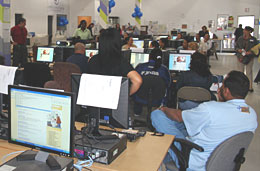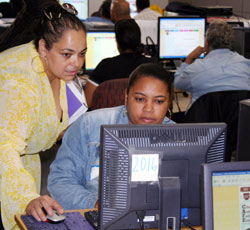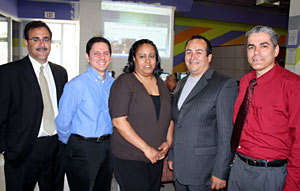Redmond, Wash., April 28, 2008 – At 44 million (1), Hispanics in the United States are now America’s largest minority (2). Comprising more than 14 percent (3) of the entire population, recent growth has seen their numbers grow by 25 percent between 2000 and 2006 (4) alone (accounting for more than half the nation’s overall population growth during this time (5)). By 2050, Latinos are expected to make up 29 percent of the US populace (6).
It’s a youthful community with a median age of 27 – compared to 40 among white Americans (7) – and disposable income projected to top $863 billion last year (8). It’s also richly diverse, spanning people of Mexican, Puerto Rican and Cuban heritage alongside people from the length and breadth of Central and South America (8). And they present a similar heterogeneity when it comes to technology usage. Hispanics are on the leading edge in many activities, observes Jose Pinero, Director of Multicultural Marketing at Microsoft. “What we find is, among Hispanics that are already online, they’re ahead of the general market in their adoption of [online] chat and downloading music, video and ringtones.”
“Then you have pockets that have not felt as comfortable with technology,” he adds.
Indeed, while Hispanics are ahead of the curve in embracing certain applications, segments of the Latino community overall remain on the wrong side of the so-called “digital divide” between groups with full access to PCs and the internet and traditionally-underserved communities.
Tackling this lingering inequity is the goal of the Vida Digital Latina campaign, launched in New York City on Friday by Microsoft and partners from the Hispanic community.
The program will deliver a series of free educational sessions in Los Angeles, Miami, San Francisco and New York over the next two months designed to increase Hispanics’ comfort level with technology, their overall computer literacy, and expose them to the very latest technology tools, such as Microsoft Windows Vista, which can be configured for both Spanish and English speaking-users.
Closing the Digital Divide

The Vida Digital Latina campaign kicked off April 24 with training sessions at New York-based Compass Computer Center. The campaign continues over the next two months with a series of free educational sessions in Los Angeles, Miami and San Francisco.
First coined as a phrase during the President Clinton era, the notion of a continuing “digital divide” can be a difficult concept to grasp today, acknowledges Jose Marquez, president and CEO of the Latinos in Information Science and Technology Association (LISTA). A partner with Microsoft on the Vida Digital Latina campaign, LISTA is dedicated to increasing Latino representation in information technology and telecommunications careers and closing the digital divide. “So many of us have computers these days, and people in Silicon Valley may believe the digital divide doesn’t exist anymore,” says Marquez. But it is still very much an everyday reality for many Hispanics, African Americans and other minorities, he points out.
Research issued last year by the Pew Hispanic Center and Pew Internet & American Life Project found that Latino internet usage still lagged that of non-Hispanic whites and non-Hispanic blacks at 56 percent versus 71 percent and 60 percent, respectively.
The report linked education, income and language proficiency to the continuing disparity. Internet usage among Latino college graduates was comparable with their similarly-educated black and white peers (89 percent versus 93 percent and 91 percent, respectively), the report found; but proportionately more Hispanics were without a degree or complete high school education – a marker for lower internet usage. Hispanic students must often juggle their schooling with jobs and looking after younger siblings while their parents work, placing them at higher risk of dropping out, says Marquez.
The report also found that while 78 percent of “English-dominant” Latinos and 76 percent of bilingual Latinos logged on to the internet, just 32 percent of “Spanish-dominant” Hispanics did.
Lower internet usage is correlated with lower income, another category in which Hispanics were overrepresented, the report added. Indeed Marquez points to a digital divide within the Latino community “between those making $50,000 and above and others earning less than $40,000, who [cannot] afford monthly internet access fees.”
Moreover, with 29 percent of Hispanic adults logging on to the internet via a home broadband connection, compared to 43 percent of white adults, the report suggests a more subtle, finer-grained digital divide, with broadband access emerging as a wedge between creative online activities and using the internet solely for basic tasks.
“Broadband users are more likely than dial-up users to shape their online environment, not just surf through it,” the report states. “For example, 32 percent of internet users with a home broadband connection have shared something online that they created themselves, such as artwork, photos, stories, or videos, compared with 20 percent of home dial-up users.”
Inadequate access to IT comes with a high price in today’s technology-intensive society. Affected groups are at greater risk of being marginalized and excluded from educational and professional opportunities opened up by the PC and internet.
Enfranchising People

Jeannette Bocanegra, Parent Involvement Coordinator for ASPIRA of New York, Inc., assists a young woman at the computer during a training session for Microsoft’s Vida Digital Latina campaign.
Both PCs and the Web represent essential tools for socioeconomic advancement, personal empowerment and educational enablement, says Marquez. One of the Vida Digital Latina campaign’s key tasks will be to overcome perceptions of technology as a “luxury” rather than an imperative, he says.
Meanwhile, technology now squarely intersects with the mission of ASPIRA of New York – Microsoft’s other partner on the initiative – to reduce the dropout rate among Hispanics and promote their educational development, says Hector Gesualdo, executive director of the New York-based non-profit organization, which has chapters across the United States.
Gesualdo puts it simply: “You cannot achieve academically anymore without knowing how to use a computer.”
Teaching parents about technology can be a big help to getting them more involved in their kids’ education. Parental engagement is considered key to students staying in school and completing their studies – amid increased use of computers and the internet for coursework and assignments, he adds. “I’m not just talking about going to school meetings, but understanding the importance of checking their children’s homework and helping [them] with the internet and computer.”
Pinero hopes the Vida Digital Latina campaign will spur more Hispanics to embrace the power of technology to unlock their potential. “It’s a chance for Microsoft to reach out to Hispanics and show them what technology can do for them and how they can really make it their own.”
“We want [people] to feel more at ease with technology, so that they can start using it not only in their everyday lives but as a tool for professional success,” Pinero adds. “This is a long-term commitment for Microsoft and one of our biggest programs to date.”
How the Program Works
The Vida Digital Latina campaign is part of a broad range of Microsoft outreach to the Hispanic community to spur their adoption of technology and close the digital divide. Last September, the company released a suite of software and services tailored to the needs of Hispanic small businesses, following this up in March with bilingual Spanish-English versions of Office Accounting Express 2008 and Office Accounting Professional 2008 that “… allow users operating in a business environment in which they must use both English and Spanish to toggle between the two as their needs dictate,” Pinero says. Last October, Microsoft launched a new Spanish-language business guide on MSN Latino, one of the most popular Hispanic web sites. The company has also partnered with leading Hispanic advocacy group, the National Council of La Raza, sponsoring their national conference and providing technology resources, and funded scholarship for leading Hispanic students.
The cornerstone of the Vida Digital Latina seminars will be hands-on sessions with Windows Vista, taught by experts.

Pictured from left to right: Frank Sobrino, Representative of ASPIRA of New York, Inc.; Jose Piñero, Director of Multicultural Marketing, Microsoft; Ingrid Ramirez, NY Ambassador for Vida Digital Latina campaign, Microsoft; Jose Ulloa, technology expert, a.k.a. “The Latino Cyber Guy”; Edwin Pérez, Representative of Compass Computer Center.
Front and center in the tutorials will be a demonstration of the operating system’s bilingual interface. “The Multi-language capability allows functionality and languages to be tied to specific users, so little Juan can use Windows Vista in English, but when Maria, his mother, logs in with her name everything changes to Spanish.” explains Pinero.
Attendees will also receive a primer on Windows Vista’s security features. Safety is of critical concern to all PC users, but it’s a paramount consideration for family-oriented Hispanics, notes Pinero. The ability to monitor and track their kids’ PC and internet usage is critical to building trust among older Hispanics, giving them the assurance that they can set boundaries, and addressing their fears about cyber predators and online scams, says Gesualdo. “It’s crucial for parents to understand how their kids are using the computer and that there are controls. There are many parents who when they see their kids using the computer think the worst with all the stories going about.”
Another key piece of functionality in Windows Vista that will be showcased is the capacity to easily view, organize and edit digital photographs and home movies in Windows Live Photo Gallery and Windows Movie Maker, and then share them with family and friends. This transforms the PC into an essential tool for families that may be dispersed not merely between different cities but across different countries to stay connected and share experiences and memories, Pinero notes.
Those unable to attend the events in person will have the chance to learn more about Windows Vista’s Hispanic-friendly features at www.windows.com/hispano as part of the Vida Digital Latina campaign. There will also be an opportunity to upgrade to Windows Vista Ultimate with Service Pack 1 at a discounted rate of $99 with purchases of qualifying PCs at Best Buy for a limited period.
Young Hispanics that have successfully forged careers in technology will be on hand at the live events to discuss their experiences and, the organizers hope, inspire others to follow in their footsteps.
According to the latest figures from the Information Technology Association of America, Hispanics comprised 6.3 percent of the IT workforce in 2002 (2).
Strength through Diversity: Developing Technology Attuned to a Broader Range of Needs
For Microsoft, promoting a diverse, inclusive workplace, welcoming to Hispanics and other minorities, simply represents good business that in turn passes on more benefits to consumers.
“As a company, we’re committed to diversity as a business principle and practice,” Pinero explains. “We want to hire the best and the brightest and we want people to be able to bring all of themselves to their job and career. That’s why it’s so important to have an environment where people’s differences are welcomed and embraced.
“We come up with better ideas if we embrace how different people approach problems. We need to have diversity in software development, [among] engineering professionals and [in] how we market [products]. At the end of the day, the products that win are those that directly address very specific customer needs. Truly understanding what makes an audience unique and talking to them in a way that is relevant, meaningful and respectful – that’s how to win the hearts and minds of Hispanics.”
1 US Census Bureau, July 16, 2007
2 Pew Hispanic Center tabulations of 2006 American Community Survey
3 Pew Hispanic Center ‘US Population Projections: 2005 – 2050
4 Pew Hispanic Center tabulations of 2006 American Community Survey
5 Pew Hispanic Center tabulations of 2006 American Community Survey
6 Pew Hispanic Center ‘US Population Projections: 2005 – 2050
7 Pew Hispanic Center tabulations of 2006 American Community Survey
9 Pew Hispanic Center tabulations of 2006 American Community Survey
11 Report of the ITAA Blue Ribbon Panel on IT Diversity Presented May 5, 2003




